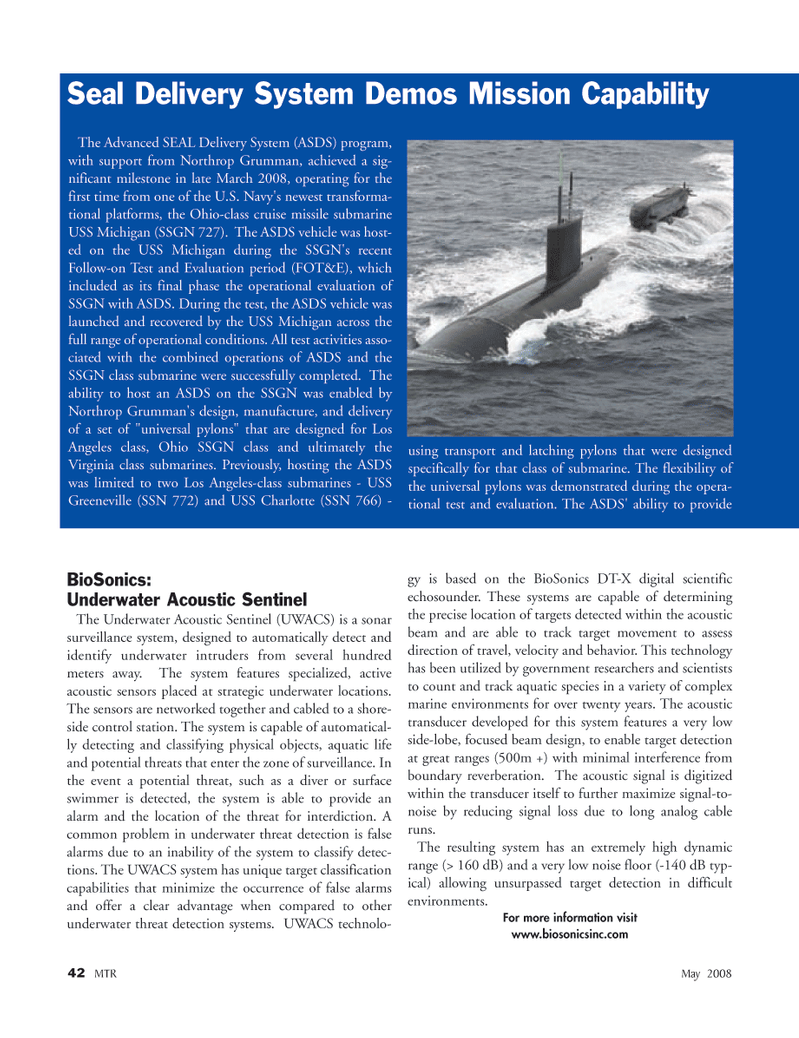
Page 42: of Marine Technology Magazine (May 2008)
Undersea Defense Edition
Read this page in Pdf, Flash or Html5 edition of May 2008 Marine Technology Magazine
42 MTR May 2008
The Advanced SEAL Delivery System (ASDS) program, with support from Northrop Grumman, achieved a sig- nificant milestone in late March 2008, operating for the first time from one of the U.S. Navy's newest transforma- tional platforms, the Ohio-class cruise missile submarine
USS Michigan (SSGN 727). The ASDS vehicle was host- ed on the USS Michigan during the SSGN's recent
Follow-on Test and Evaluation period (FOT&E), which included as its final phase the operational evaluation of
SSGN with ASDS. During the test, the ASDS vehicle was launched and recovered by the USS Michigan across the full range of operational conditions. All test activities asso- ciated with the combined operations of ASDS and the
SSGN class submarine were successfully completed. The ability to host an ASDS on the SSGN was enabled by
Northrop Grumman's design, manufacture, and delivery of a set of "universal pylons" that are designed for Los
Angeles class, Ohio SSGN class and ultimately the
Virginia class submarines. Previously, hosting the ASDS was limited to two Los Angeles-class submarines - USS
Greeneville (SSN 772) and USS Charlotte (SSN 766) - using transport and latching pylons that were designed specifically for that class of submarine. The flexibility of the universal pylons was demonstrated during the opera- tional test and evaluation. The ASDS' ability to provide
Seal Delivery System Demos Mission Capability
BioSonics:
Underwater Acoustic Sentinel
The Underwater Acoustic Sentinel (UWACS) is a sonar surveillance system, designed to automatically detect and identify underwater intruders from several hundred meters away. The system features specialized, active acoustic sensors placed at strategic underwater locations.
The sensors are networked together and cabled to a shore- side control station. The system is capable of automatical- ly detecting and classifying physical objects, aquatic life and potential threats that enter the zone of surveillance. In the event a potential threat, such as a diver or surface swimmer is detected, the system is able to provide an alarm and the location of the threat for interdiction. A common problem in underwater threat detection is false alarms due to an inability of the system to classify detec- tions. The UWACS system has unique target classification capabilities that minimize the occurrence of false alarms and offer a clear advantage when compared to other underwater threat detection systems. UWACS technolo- gy is based on the BioSonics DT-X digital scientific echosounder. These systems are capable of determining the precise location of targets detected within the acoustic beam and are able to track target movement to assess direction of travel, velocity and behavior. This technology has been utilized by government researchers and scientists to count and track aquatic species in a variety of complex marine environments for over twenty years. The acoustic transducer developed for this system features a very low side-lobe, focused beam design, to enable target detection at great ranges (500m +) with minimal interference from boundary reverberation. The acoustic signal is digitized within the transducer itself to further maximize signal-to- noise by reducing signal loss due to long analog cable runs.
The resulting system has an extremely high dynamic range (> 160 dB) and a very low noise floor (-140 dB typ- ical) allowing unsurpassed target detection in difficult environments.
For more information visit www.biosonicsinc.com
MTR#4 (33-48).qxd 5/13/2008 10:26 AM Page 42

 41
41

 43
43
